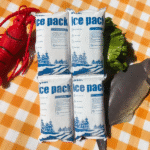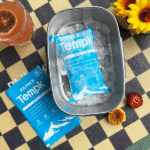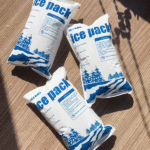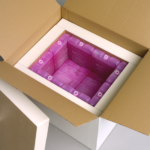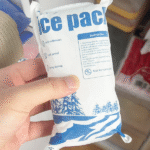Imagine a delicate vaccine or a box of berries traveling hundreds of miles to your door. Without constant temperature control, both would spoil long before they reached you. That system of refrigeration, monitoring and careful handling is called the سلسلة البرد, and it’s the backbone of modern food and medicine distribution. في 2025 the global cold chain logistics market is booming—estimates suggest it will grow from about US$293 billion in 2023 to more than US$862 billion by 2032—and keeping up means understanding how it works. This guide, updated on 13 نوفمبر 2025, demystifies the cold chain, explains its components, explores emerging trends and shows you how it can benefit your business.
ما سلسلة البرد is and how it works, including its role in food, pharmaceuticals and other sensitive products.
Key components of cold chain logistics—cooling systems, تخزين, النقل والمراقبة.
Benefits and challenges of maintaining a cold chain, with practical examples and solutions.
How to implement cold chain best practices, covering compliance, temperature standards and staff training.
2025 الاتجاهات والابتكارات مثل أجهزة استشعار إنترنت الأشياء, AI and blockchain that are reshaping temperature controlled logistics.
الأسئلة المتداولة and answers about cold chain management.
What is the cold chain and how does it work?
ال سلسلة البرد is a specialised supply chain designed to handle, store and transport temperature sensitive goods under strict temperature controls. Instead of a regular chain where goods may sit in ambient conditions, cold chain logistics use refrigeration, insulated packaging and real time monitoring to protect products from spoilage. An industry guide defines it succinctly as the process of التعامل, storing and transporting perishable goods under temperature controlled conditions. أ 2025 report further explains that this continuous refrigeration—from manufacturing through warehousing and distribution—preserves product quality from production to consumption.
في الممارسة العملية, the cold chain combines science, technology and process discipline. طعام, اللقاحات, البيولوجيا, المواد الكيميائية, cosmetics and even musical instruments may require refrigeration or controlled humidity to stay safe. Unlike an ordinary supply chain, the cold chain relies on continuous refrigeration and monitoring across every stage. Minor temperature deviations can degrade vaccines or cause seafood to spoil. To prevent such losses, the cold chain is built from several interconnected components: cooling systems, التخزين البارد, temperature controlled transport and sophisticated monitoring.
Components of the cold chain: تبريد, storage and transport
أنظمة التبريد. Cooling equipment lowers product temperatures to safe ranges and keeps them there. Refrigerated containers, blast freezers and liquid nitrogen systems are common; they maintain constant temperatures during transit and pre cool products quickly. Cryogenic freezers can reach ultra low temperatures below −80 °C for biologics and gene therapies. These technologies prevent spoilage and maintain potency.
التخزين البارد. Warehouses and cold rooms provide controlled environments for long term storage. Large refrigerated warehouses use insulated panels, compressors, condensers and automated storage and retrieval systems to prevent cold air leakage and temperature spikes. Smaller cold rooms house specific products at set temperatures. Facilities maintain several temperature ranges: المحيط (15-30 درجة مئوية), رائع (10-15 درجة مئوية), مبردة (0-10 درجة مئوية) وتجميد (−30 °C to 0 درجة مئوية). Ultra low ranges below −80 °C are used for cell and gene therapies.
Transport and distribution. Specialised vehicles—refrigerated trucks, ships and aircraft—keep goods within the proper temperature during transit. For everyday food shipments, fresh goods travel at +2 درجة مئوية إلى +8 °C while frozen foods require about −20 °C; some pharmaceuticals demand −60 °C or lower. Transport isn’t limited to food and medicine; قطع الزهور, مستحضرات التجميل, varnishes, musical instruments and certain electronics also need controlled temperatures. Containers may also need humidity or pressure control, and sometimes even heating—for example, oils or wooden instruments can warp if they get too cold.
Monitoring and control. Sensors and data loggers continuously record temperature and humidity, sending alerts if readings stray from safe ranges. Modern systems use مستشعرات إنترنت الأشياء, GPS and RFID tags to provide real time visibility across the supply chain. In advanced facilities, telematics and emergency cooling systems automatically correct deviations or alert personnel. Monitoring ensures early detection of issues and proof of compliance.
Typical cold chain temperature ranges
| نطاق درجة الحرارة | Examples of products | لماذا يهم |
| المحيط (15-30 درجة مئوية / 59–86 °F) | Dry foods, بعض المستحضرات الصيدلانية | Minimal refrigeration needed; still requires ventilation to avoid heat buildup. |
| رائع (10-15 درجة مئوية / 50–59 °F) | Cheese, المنتجات الطازجة | Preserves flavour and texture; uses insulated containers and short transport times. |
| مبردة (0-10 درجة مئوية / 32–50 °F) | اللقاحات, منتجات الألبان | Prevents bacterial growth and maintains freshness. |
| المجمدة (−30 °C to 0 درجة مئوية / −22 °F to 32 ° f) | لحمة, المأكولات البحرية, الحلويات المجمدة | Provides long term preservation; requires deep freezing equipment and backup power. |
| Ultra low (below −80 °C / below −112 °F) | البيولوجيا, لقاحات مرنا | Demands cryogenic freezers and redundant power to avoid catastrophic loss. |
Practical tips and user scenarios
For farm to table food businesses: Use insulated packaging and gel packs for shipments under 48 ساعات, and choose carriers with refrigerated trucks. Ensure the temperature remains between +2 درجة مئوية و +8 °C for fresh produce. Implement IoT sensors to alert you if the temperature rises.
For pharmacies and clinics: Store vaccines between +2 درجة مئوية و +8 °C and avoid exposing them to freezing temperatures. Use medical grade refrigerators and digital data loggers to monitor conditions.
For flower shops or art handlers: Maintain a cool, slightly humid environment when shipping cut flowers or artwork; temperatures that are too cold can damage them. Pack items with moisture absorbent materials and monitor humidity alongside temperature.
دراسة حالة: During the distribution of mRNA COVID 19 vaccines, logistics providers had to maintain temperatures of −60 °C to −70 °C أثناء النقل. Using specialised cryogenic containers and continuous monitoring, they kept the vaccines within range, ensuring doses remained effective when administered.
Benefits and challenges of cold chain logistics
Implementing a robust cold chain yields significant benefits. By keeping products within safe temperature ranges, الشركات reduce spoilage and increase revenue per shipment. Customers receive better quality goods, leading to higher satisfaction and loyalty. The cold chain also opens access to new markets—fresh produce from another continent or pharmaceuticals delivered to remote communities—while helping companies comply with strict regulations such as those enforced by the Food and Drug Administration and the World Health Organization.
لكن, cold chain logistics also pose challenges. Temperature fluctuations can occur during loading, power failures or long transit times. Inadequate packaging may allow products to warm or freeze unexpectedly. Contamination risks are heightened when goods share space with incompatible materials. بالإضافة إلى, the need for specialised equipment, trained staff and documentation increases operational complexity and cost.
Common challenges and solutions
| تحدي | Risk to your product | How to mitigate |
| Disrupted temperature control | Even brief exposure outside the safe range can render vaccines or food unusable. | Use scalable refrigeration systems and redundant power; equip vehicles with backup cooling and continuously monitor temperatures. |
| Inadequate packaging | Damaged packaging exposes goods to heat or moisture; shipments arrive spoiled. | Choose insulation that matches product needs (حزم هلام, لوحات فراغ); apply RFID tracking to detect incidents and act quickly. |
| Contamination and cross contact | Exposure to other chemicals or bacteria can compromise products. | Segregate storage areas, follow sanitation protocols and train staff in handling procedures. |
| عدم الامتثال التنظيمي | Failing to meet Good Distribution Practices can lead to recalls, fines and reputational damage. | Maintain accurate records, use validated equipment and calibrate devices regularly. |
Cold chain breaches carry serious consequences: تدهور المنتج, public health risks, الخسائر المالية, regulatory action, reputational damage and supply disruptions. على سبيل المثال, one study cited that حتى 35 % of vaccines are compromised by temperature mishandling—a costly waste and a threat to public health. Recognising the risks helps organisations implement preventive measures.
User tips for overcoming challenges
Conduct regular temperature mapping: Periodically test storage areas to identify hot and cold spots, perform power failure simulations and adjust procedures accordingly.
Follow the First In, First Out (يصرف أولاً) طريقة: Sell or distribute older stock first to minimise waste and ensure compliance.
Label and organise inventory: Clearly mark expiry dates and storage conditions; arrange shelves to allow proper airflow.
تدريب فريقك: Everyone handling cold chain goods should understand temperature requirements, emergency procedures and record keeping.
Plan for emergencies: Prepare contingency plans for power outages, equipment failures and transport delays; stock emergency generators and backup ice packs.
مثال العالم الحقيقي: A regional dairy cooperative cut spoilage by 25 % after implementing IoT temperature sensors and switching to thicker insulated cartons. Real time alerts enabled drivers to correct issues before products warmed, and the investment paid for itself within a season.
Cold chain compliance and best practices: your step by step guide
Compliance with national and international standards is essential. Regulatory bodies such as the FDA, ال وكالة الأدوية الأوروبية (ema) و World Health Organization enforce Good Distribution Practices (الناتج المحلي الإجمالي) that cover temperature control, validated systems, التتبع والموظفين المدربين. Compliance also involves calibration standards like NIST أو UKAS, electronic data integrity guidelines (EU GMP Annex 11) and country specific rules.
Core cold chain requirements
Meeting compliance standards requires attention to several elements:
Accurate temperature maintenance: Keep products within tightly controlled ranges—typically 2 درجة مئوية إلى 8 درجة مئوية للسلع المبردة, -20 درجة مئوية for standard freezing and below −70 °C for ultra low storage.
24/7 يراقب: Use automated data loggers and real time systems to track temperatures continuously. Choose devices with alarms for excursions.
البنية التحتية المعتمدة: Invest in certified refrigeration units, transport containers and monitoring tools that perform consistently.
Secure storage environments: Restrict access and maintain separate zones for different products.
Specialist packaging: Use thermal packaging such as insulated shippers, phase change materials and gel packs to maintain temperatures during transit.
Detailed record keeping: Log temperature data, شهادات المعايرة, training records and any deviations.
Contingency plans: Prepare protocols for power failures, equipment breakdowns and temperature excursions.
الموظفين المدربين: Ensure personnel are trained in handling, الرصد والاستجابة لحالات الطوارئ.
Best practice checklist
Use medical grade equipment: Domestic fridges fluctuate too much for sensitive vaccines; choose equipment designed for pharmacy use.
Monitor temperatures in real time: Digital data loggers and wireless alert systems provide live updates and alarms.
Calibrate and maintain equipment: Calibrate thermometers and freezers at least twice a year and document maintenance.
Adopt FIFO inventory management: Rotate stock to avoid expired goods.
التسمية بوضوح: Include expiry and receiving dates on all packages.
Train regularly: Hold short, focused training sessions every few months to keep staff aware of proper procedures.
Plan for emergencies: Keep backup power sources and SOPs for power cuts or transport delays.
Document everything: Maintain digital records of temperatures, maintenance and incidents for audits.
Cold chain readiness checklist
Use this self assessment to see how prepared your organisation is. For each question, إجابة نعم أو لا:
Do you know the exact temperature range your products require?
Are all your storage units fitted with calibrated thermometers and data loggers?
Do you monitor temperatures continuously and receive alerts for excursions?
Are your packaging materials rated for the transit conditions you expect?
Does your team receive ongoing training on cold chain handling and emergency procedures?
Do you have documented contingency plans for power failures and transport delays?
Do you perform regular temperature mapping and equipment maintenance?
Do you keep detailed records of temperatures, calibration and corrective actions?
If you answered لا to any question, that area deserves attention. Addressing gaps now will protect product quality and help you comply with regulations.
نصيحة: Consider partnering with an experienced cold chain provider if maintaining your own infrastructure is impractical. Specialists can offer validated equipment, trained personnel and real time monitoring services tailored to your needs.
2025 cold chain trends and innovations
The cold chain landscape is evolving quickly. Market analysts report that the global cold chain logistics market was valued at دولار أمريكي 293.58 مليار في 2023 ومن المتوقع أن تصل إلى دولار أمريكي 862.33 مليار من قبل 2032. Another study estimates the market at US$436.30 billion in 2025, expecting it to surpass US$1.3 trillion by 2034. These figures reflect rising demand for fresh food, البيولوجيا, vaccines and other temperature sensitive products across the world.
Emerging trends shaping the cold chain
Geopolitical resilience and capacity planning. Disruptions such as geopolitical unrest, trade tariffs and black swan events have affected transit times and capacity. Cold chain operators are investing in flexible capacity and diversified routes to maintain service, and experts note that the market is ready to cope with future disruptions.
Enhanced visibility through software. Real time data platforms improve tracking and temperature monitoring, giving stakeholders the insights needed to act quickly. Visibility is crucial when handling temperature sensitive cargo; continuous data enables immediate responses to deviations and better inventory planning.
New products and dietary shifts. The rise of plant based proteins, gluten free and organic foods is reshaping refrigerated transportation. Plant based foods could make up 7.7 % سوق البروتين العالمي من خلال 2030, bringing with them new temperature requirements and supply chain complexities.
Modernisation of cold storage facilities. Ageing warehouses—some built 40–50 years ago—are being replaced or upgraded to improve energy efficiency, automation and integration. Regulatory pressure to phase out environmentally harmful refrigerants (HCFCs and HFCs) accelerates these upgrades.
IoT and sensor technology. IoT devices provide real time monitoring of temperature, الرطوبة والموقع, allowing businesses to detect and address issues promptly. These sensors reduce waste and ensure product quality.
Blockchain من أجل الشفافية. Blockchain creates an immutable, transparent ledger of transactions. It improves traceability and helps guarantee that products remain within safe temperature ranges. In pharmaceutical cold chains, blockchain reduces data manipulation and enhances compliance.
Artificial intelligence and predictive analytics. يعمل الذكاء الاصطناعي على تحسين الطرق, forecasts demand and identifies potential disruptions before they occur. Combining AI with historical temperature data lets operators prevent excursions and schedule maintenance proactively.
Solar powered cold storage. Remote regions with unstable electricity supply are adopting solar powered cold rooms to protect vaccines and perishable goods. These units cut energy costs and provide reliable refrigeration.
المجمدات المبردة المحمولة. For biologics and cell therapies requiring temperatures as low as -150 درجة مئوية, portable cryogenic freezers offer mobility and continuous ultra cold conditions.
Sustainable packaging and reduced temperatures. Businesses are shifting to biodegradable insulation, reusable containers and energy efficient designs. Some cold storage operators aim to change frozen storage standards from −18 °C to −15 °C to reduce energy consumption.
Market growth visualised
To illustrate the rapid expansion of cold chain logistics, the chart below plots projected market size from 2021 ل 2034. The trend shows exponential growth, reflecting increased demand across industries.
Innovations and their impact
| ابتكار | فائدة عملية | Typical use case |
| IoT sensors and GPS tracking | Real time temperature and location data; immediate alerts prevent spoilage. | Monitoring vaccine shipments, perishable foods and floral products. |
| إمكانية تتبع البلوكشين | Immutable record of every transaction; improved accountability and trust. | Tracking pharmaceuticals from manufacturer to patient; ensuring authenticity of organic foods. |
| تحسين المسار القائم على الذكاء الاصطناعي | Reduced transit time and predictive identification of temperature excursions. | Planning delivery routes for remote clinics or congested urban areas. |
| Solar powered cold storage | موثوق, off grid refrigeration; lower energy costs and emissions. | Storing vaccines in rural communities without stable electricity. |
| المجمدات المبردة المحمولة | Maintain ultra low temperatures (down to −150 °C) for biologics and cell therapies. | Transporting gene therapies or mRNA vaccines to remote hospitals. |
| التغليف المستدام & reduced temperature standards | Cuts waste and carbon footprint; new standards like −15 °C reduce energy use. | شحن الأطعمة المجمدة, pharmaceuticals and specialty products. |
نتطلع إلى الأمام
As technology matures and regulatory standards evolve, the cold chain is poised for further growth. Businesses adopting IoT, AI and sustainable practices will enhance transparency, reduce waste and meet consumer expectations for quality and environmental responsibility. Companies that modernise their infrastructure and invest in training and compliance will be better positioned to serve the expanding market for temperature sensitive goods.
الأسئلة المتداولة
- What temperature range should vaccines be stored at?Most vaccines must be kept between +2 درجة مئوية و +8 درجة مئوية; frozen vaccines like varicella require −50 °C to −15 °C, and ultra cold vaccines such as mRNA boosters need −80 °C to −60 °Cfor long term storage. Once thawed, many vaccines can be kept at +2 درجة مئوية إلى +8 °C for a limited period. Always consult manufacturer guidelines and use digital data loggers to monitor temperatures.
- How is a cold chain different from a normal supply chain?A traditional supply chain moves goods without strict temperature control. على النقيض من ذلك, the cold chain uses specialised refrigeration equipment, insulated packaging and continuous monitoring to maintain products within precise temperature ranges. It also requires detailed documentation, validated infrastructure and compliance with regulatory standards.
- Which industries rely on the cold chain?Food and beverage companies use cold chain logistics to keep produce, ألبان, meat and seafood fresh from farm to table. The pharmaceutical industry relies on it to maintain vaccine potency and drug efficacy. Other users include biotechnology firms, chemical manufacturers, florists, museums and electronics producers.
- What happens when the cold chain is breached?A breach—or temperature excursion—occurs when products stray from their designated range. Consequences include تدهور المنتج, public health risks, الخسائر المالية, regulatory action and reputational damage. للقاحات, even brief exposure above +8 °C can degrade up to 20 % of potency. Prevent breaches with redundant systems, continuous monitoring and training.
- How can a small business start using cold chain logistics?Begin by identifying your products’ temperature requirements. Use insulated packaging and gel packs for short shipments and partner with carriers that offer refrigerated transport. Invest in affordable data loggers and cloud based monitoring. Train staff in handling procedures and maintain a record keeping system to demonstrate compliance.
Summary and actionable recommendations
This guide explored the fundamentals of the cold chain, explaining how continuous temperature control preserves vaccines, طعام, chemicals and more. We examined the key components—cooling systems, التخزين البارد, transport and monitoring—and highlighted typical temperature ranges from ambient to ultra low. The benefits of cold chain logistics include reduced spoilage, higher customer satisfaction and access to new markets, while challenges involve temperature disruptions, inadequate packaging and regulatory complexity. Compliance requires accurate temperature maintenance, البنية التحتية المعتمدة, يراقب, الوثائق, contingency planning and trained staff.
خطة العمل:
Assess your product needs. Identify the exact temperature requirements for each product.
Invest in the right infrastructure. Use certified refrigeration equipment, insulated packaging and validated vehicles.
تنفيذ المراقبة في الوقت الحقيقي. Deploy IoT sensors and data loggers to track temperature, الرطوبة والموقع بشكل مستمر.
تدريب فريقك. Regularly educate staff on handling procedures, emergency response and compliance requirements.
اعتماد الممارسات المستدامة. Explore eco friendly packaging, energy efficient systems and lower temperature standards where appropriate.
احتضان الابتكار. Evaluate new technologies like AI driven route optimisation, blockchain and solar powered storage.
Create contingency plans. Prepare for power outages, equipment failures and transport delays; maintain backup systems and emergency protocols.
من خلال اتباع هذه الخطوات, you can build a resilient cold chain that protects product quality, meets regulatory standards and satisfies customers.
حول Tempk
Tempk specialises in innovative cold chain packaging and logistics solutions. We design and manufacture a wide range of insulated boxes, حزم هلام, ice packs and electric cooler bags for food delivery, pharmaceuticals and biotech applications. Our products use high performance materials such as vacuum insulation panels and phase change media to maintain stable temperatures for extended periods. We prioritise sustainability by offering reusable and recyclable options and continually invest in research and development to reduce carbon footprints. With strict quality control and Sedex certification, we help clients navigate regulatory requirements and ensure that temperature sensitive goods arrive safely and on time.
دعوة إلى العمل: Whether you’re shipping artisanal cheese or life saving vaccines, our experts can help you design a temperature controlled solution tailored to your needs. اتصل بنا اليوم to discuss your cold chain challenges and explore our range of packaging and monitoring solutions.

















